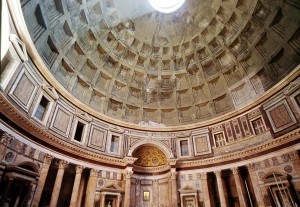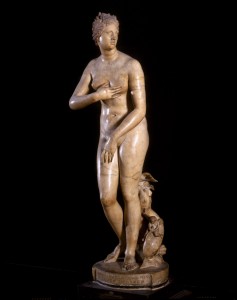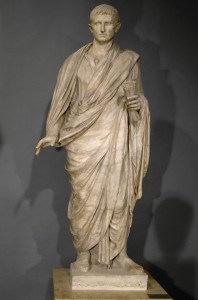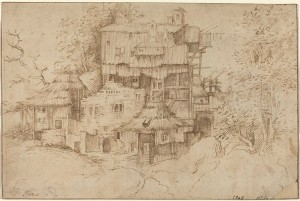
Circle of Giorgione
Rustic Houses Built among Ruins, 1510/1513
Pen and brown ink on laid paper, 17.7 x 26.6 cm (6 15/16 x 10 1/2 in.)
National Gallery of Art, Washington, DC, Woodner Collection
Image courtesy of the Board of Trustees, National Gallery of Art
Art and architecture flourished during the Roman Empire (27 BC–AD 476). Under Roman rule, ambitious building programs, civic improvements, and sculptural monuments transformed the capital city and its dependent territories across Italy, Europe, and the Mediterranean. Working in the classical style perfected in Greece during the fifth century BC, the Romans applied Greek systems of ideal proportion, symmetry, and harmony to their own distinctive aims and preferences. Innovative use of the arch, the vault, and the dome allowed architects to advance beyond the Greeks’ post-and-lintel construction to more complex designs commensurate with the Roman predilection for grandeur and massiveness. Extensive use of concrete (usually faced with brick, stone, or marble) achieved the strength and durability that made Roman building legendary. Demand for Greek statues of nude or lightly draped Greek athletes, gods, and goddesses fueled a brisk trade in copies. Original Roman sculpture (chiefly contemporary portraits, historical reliefs, and funerary monuments) exhibited a more subdued form of classicism, tempered by the dignified gravitas that defined the noble Roman ethos.
The Pantheon
Completed around AD 126 as a temple dedicated to all the Roman gods, the Pantheon remains a marvel of engineering. It boasts the world’s largest unreinforced concrete dome and a structure of remarkable geometric regularity. A rectangular portico surmounted by a triangular pediment opens onto a circular building with a coffered dome. The height of the dome equals the diameter of the interior at ground level. Constant use spared the pagan temple from destruction. In the seventh century, it was consecrated as a Roman Catholic church dedicated to Saint Mary and the Martyrs.
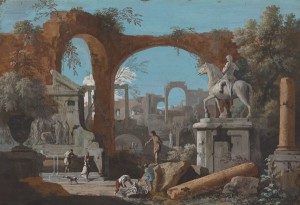
Marco Ricci
A Capriccio of Roman Ruins, 1720s
Gouache on kidskin, 31.5 x 46 cm (12 3/8 x 18 1/8 in.)
National Gallery of Art, Washington, DC, Ailsa Mellon Bruce Fund
Image courtesy of the Board of Trustees, National Gallery of Art
The political collapse of the Roman Empire came swiftly in AD 476, four years after Barbarians from the north sacked the capital for a third time and crippled the authority of the imperial government. The empire’s physical destruction began simultaneously but proved far more difficult to achieve. Warfare took a continual toll on the magnificent buildings and monuments of the capital and its outposts. New religious views did even more damage. Believing it heretical to permit the survival of temples and statues dedicated to pagan gods, leaders of the early Christian church encouraged the faithful to destroy all vestiges of polytheism. Pope Gregory the Great (c. 540–604), according to an early church historian, “resolved and ordered that the heads and limbs of all the images of demons that could be found inside and outside the city of Rome, be amputated and broken into pieces, so that the plan of ecclesiastical truth would be more fully exalted, with the eradication of the roots of wicked heresy.”1 Shattered statues were used as building materials, burned to produce lime, or piled into ships as ballast. Temples dedicated to the pagan gods were either co-opted for Christian worship or disassembled so that their stones could be recycled to erect new churches. (Read Historic preservation in Renaissance Italy.)
Roman Statuary
From about 81 BC to AD 330, Greek sculptors working in various outposts of the Roman Empire produced innumerable replicas and adaptations of famous Greek sculptures for connoisseurs as well as the mass market. The Venus de’ Medici, shown here, was based on a renowned life-size statue of Aphrodite, the Greek goddess of love. The original Greek bronze no longer survives (presumably melted down long ago for its material) and is known today only through marble copies such as this.
The reign of the Emperor Augustus (27 BC – AD 14) initiated an era of philhellenism in Roman art. The sober realism that had distinguished portrait sculpture of the Republican era, combined with Greek idealism, created a distinctive hybrid style. In this portrait of Augustus, recognizable facial traits clearly identify the individual represented, yet the perfected physiognomy and calm expression serve a propagandistic purpose, reinforcing our sense of the almost superhuman nobility and command of the ruler.
Yet not even several centuries of warfare, iconoclasm, and vandalism could eradicate evidence of Italy’s glorious imperial past. In the thousand years that elapsed between the fall of the Roman Empire and the “rebirth” of ancient culture in the fifteenth century, fragments of antiquity remained an integral part of the physical environment. On a diplomatic mission to Italy in 1411, the Greek teacher and writer Manuel Chrysoloras (c. 1350–1415) expressed astonishment at the ubiquity and high quality of ancient works of art scattered about the city of Rome:
Walking through the streets one finds at every corner sculpted reliefs representing episodes from the ancient Greek myths…; these one can find on the sides of sarcophagi and even cemented into the walls of private houses; and each are the work of the very finest sculptors—a Phidias, a Praxiteles, or a Lysippus!2
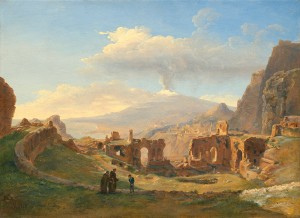
Louise-Joséphine Sarazin de Belmont
The Roman Theater at Taormina, 1828
Oil on paper on canvas, 43.2 x 59.7 cm (17 x 23 1/2 in.)
National Gallery of Art, Washington, DC, Gift of Frank Anderson Trapp
Image courtesy of the Board of Trustees, National Gallery of Art
Italian cities well beyond Rome boasted their own vestiges of ancient culture, such as aqueducts, triumphal arches, gates, walls, and temples. A drawing of rustic houses standing among Roman ruins by an artist in the circle of the Venetian painter Giorgione captures an impression of the casual mingling of ancient and modern in the Italian landscape. Succeeding generations of artists would capitalize on the poignancy of these random traces of the once mighty Roman Empire. In the eighteenth and nineteenth centuries, ruins often played a starring role in landscape paintings, for example Marco Ricci’s architectural fantasy A Capriccio of Roman Ruins, 1720s, or Louise-Joséphine Sarazin de Belmont’s romanticized topographical view (or capriccio) The Roman Theater at Taormina, 1828.
